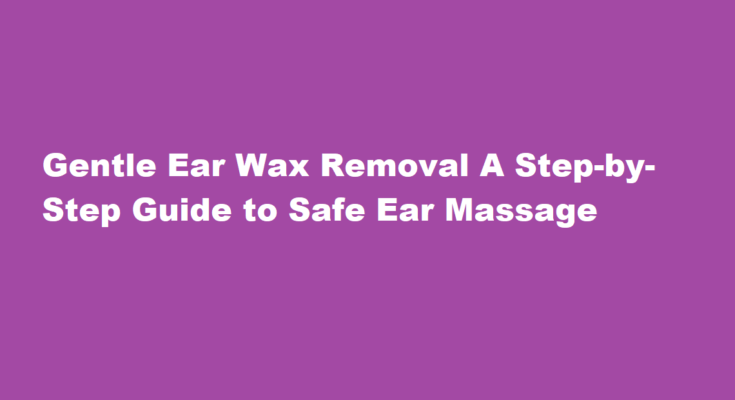Introduction
Earwax, also known as cerumen, is a natural substance produced by the ear to protect it from dust, debris, and infection. However, when earwax accumulates excessively, it can cause discomfort and even affect hearing. While many people resort to cotton swabs, they can push the wax further into the ear canal, potentially causing damage. A safer and more effective alternative is ear massage, which can help soften and coax the wax out naturally. In this article, we will explore the steps involved in this gentle technique to ensure a safe and efficient earwax removal process.
Understanding Earwax
Before attempting earwax removal, it’s crucial to understand the nature of earwax. Earwax is a combination of dead skin cells, hair, and secretions from the ceruminous glands in the ear canal. Its primary function is to trap foreign particles and prevent them from entering the inner ear. However, when too much earwax accumulates, it can cause hearing loss, tinnitus, dizziness, or earaches. It’s important to differentiate between impacted earwax and regular earwax buildup; impacted wax may require professional intervention.
Preparation
1. Gather your supplies To begin, ensure you have the necessary items: a clean, soft washcloth, warm water, a dropper, and hydrogen peroxide (optional).
2. Wash your hands Clean hands are essential to prevent any contamination during the process.
3. Choose a comfortable location Find a quiet and well-lit space where you can comfortably sit or lie down.
The Massage Technique
1. Start with warm water To soften the earwax, soak a clean washcloth in warm water (not too hot) and gently wring it out.
2. Tilt your head Tilt your head so that the ear you want to clean is facing upwards.
3. Apply warm compress Place the warm, damp washcloth over your ear and hold it there for 5-10 minutes. This step helps to soften the earwax and make it more pliable for removal.
4. Use hydrogen peroxide (optional) If you have hydrogen peroxide, mix it with an equal amount of warm water and use a dropper to put a few drops into your ear canal. This can help further soften the wax.
5. Massage the ear After the earwax is softened, gently massage the area around your ear canal in a circular motion. This motion helps to move the earwax toward the ear’s entrance.
6. Let gravity do its work Keeping your head tilted, you can allow the softened earwax to naturally drain out. You may want to place a tissue or cotton ball at the entrance of your ear to catch any excess wax and prevent it from flowing deeper into the ear canal.
Safety and Caution
It’s important to exercise caution during this process
1. Never insert objects into your ear canal, such as cotton swabs or hairpins, as they can push the earwax deeper or cause injury.
2. If you experience pain, discomfort, or worsening symptoms during the process, stop immediately and seek professional help.
3. Do not attempt earwax removal if you have a history of ear infections, a perforated eardrum, or other ear issues. Consult a healthcare professional instead.
4. This technique is not suitable for children, as their ear canals are smaller and more delicate.
FREQUENTLY ASKED QUESTIONS
What dissolves ear wax fast?
Your provider can also flush out the wax using a syringe filled with warm water and saline or diluted hydrogen peroxide. Medicated ear drops may also be recommended to help soften the wax, such as carbamide peroxide (Debrox Earwax Removal Kit, Murine Ear Wax Removal System).
What destroys ear wax?
If you have a small amount of wax, over-the-counter ear cleaners work well. Look for drops that contain hydrogen peroxide or other kinds of peroxide. The peroxide does a good job of breaking up earwax. Lay sideways: Make sure the ear you’re cleaning faces up and add the drops as directed.
Conclusion
Earwax removal through gentle massage can be an effective and safe way to manage earwax buildup. However, it’s crucial to approach this process with care and patience. Regular cleaning of the outer ear with a washcloth after bathing can also help prevent excessive earwax accumulation. If you have concerns about your ear health or experience persistent symptoms, consult a healthcare professional for a thorough evaluation and appropriate treatment. Remember that preserving your hearing health is essential, and a gentle approach to earwax management can contribute to your overall well-being.
Read Also : how to draw the grinch



